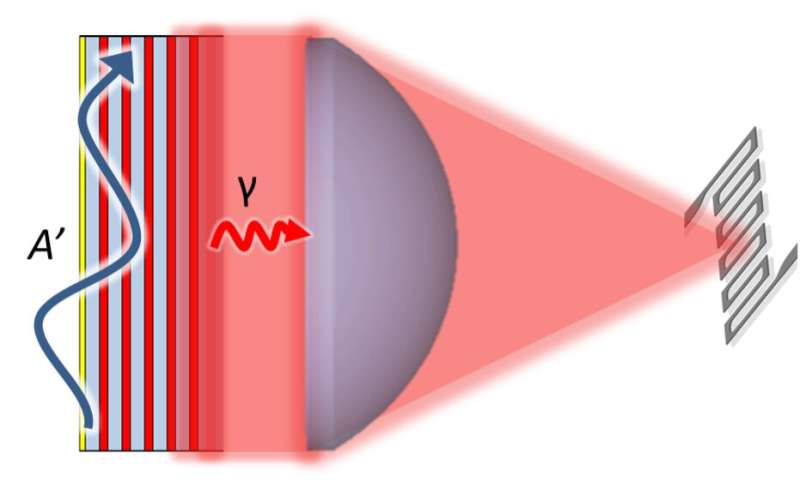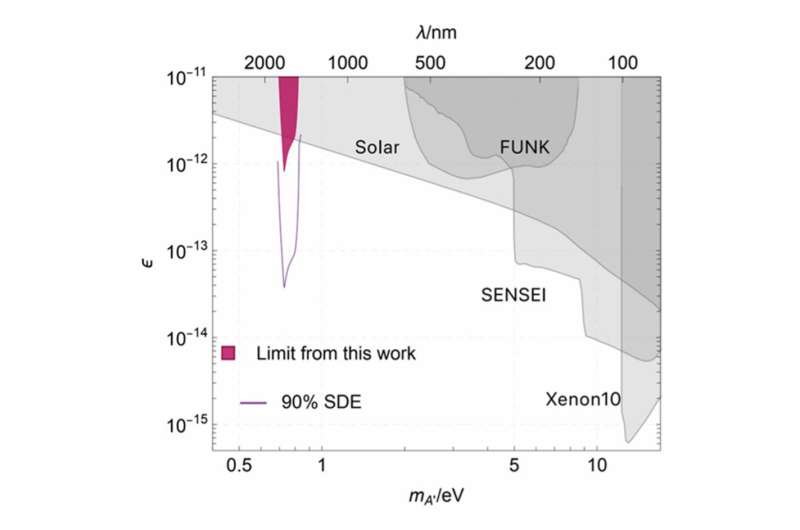July 6, 2022 feature
Study sets new constraints on dark photons using a new dielectric optical haloscope

Researchers at the National Institute of Standards and Technology (NIST), Massachusetts Institute of Technology (MIT) and the Perimeter Institute recently set new constraints on dark photons, which are hypothetical particles and renowned dark matter candidates. Their findings, presented in a paper published in Physical Review Letters, were attained using a new superconducting nanowire single-photon detector (SNSPD) they developed.
"There's a close collaboration between our research groups at NIST and MIT, run by Dr. Sae Woo Nam and Prof. Karl Berggren, respectively" Jeff Chiles, one of the researchers who carried out the study, told Phys.org. "We work together to advance the technology and applications for ultra-sensitive devices called superconducting nanowire single-photon detectors or SNSPDs. "
Over the past few years, Chiles and his colleagues have been considering potential applications that would benefit from the SNSPD detectors they have been working on, which have virtually no background noise among other advantageous characteristics. They were eventually introduced to a group of theoretical physicists from the Perimeter Institute for Theoretical Physics in Canada.
This team of theorists had an interesting idea for a dark matter detector that could operate in an entirely different domain from those currently employed in dark matter searches. This detector, namely a multilayer dielectric optical haloscope, was a highly promising concept, yet it would require an optical detector that could perform far better than those on the market today.
"This turned out to be the perfect match, as the MIT and NIST groups could build the detector and the apparatus and test it out," Chiles explained. "So, we teamed up and called our project LAMPOST (Light A' Multilayer Periodic Optical SNSPD Target). Our goal was to achieve the first experimental proof-of-concept for this idea and prove that it could be used to search for dark matter with better sensitivity than the already established bounds."
The optical detector devised by Chiles and his colleagues is based on a structure known as a dielectric stack or target. This structure can generate signal photons of interest, by converting a nonrelativistic dark photon into a relativistic photon in the same frequency.

"First, we performed analysis of the construction of the apparatus, optical simulations to determine the optical collection efficiency, simulation of the detection efficiency, calculation of the influence of polarization on the dark matter signal and the minimum signal power that is compatible with the possible range of target properties," Ilya Charaev, another researcher involved in the study, told Phys.org. "Using the SNSPD technique, all incoming signals were registered over a 180-hour exposure."
To set a limit on the dark matter coupling, the researchers estimated the dark count rate, also referred to as "noise" for the SNSPD detector they developed. Interestingly, their estimated noise value is the lowest among all values reported in physics literature.
"Notably, we succeeded in our goal, as we were able to scan for a type of dark matter, specifically 'dark photons,' twice as sensitively as anything else in the energy range that we searched," Chiles said. "In the grand scheme of things, this is still a small notch out of a huge range of possibilities for dark matter. But for our first run to exceed existing bounds is an important first step, and to me, this speaks to the power and simplicity of the multilayer dielectric optical haloscope approach."
In their experiments, this team of researchers gathered valuable insight that could inform future searches for dark photons, while also potentially encouraging the use of SNSPDs. In addition to setting new constraints on dark photons, in fact, Chiles and his colleagues learned more about their detector's capabilities.
Most notably, they found that the noise in their detector was incredibly low. More specifically, the team only observed 5 "false events" for one of their single-photon detectors over 180 hours of data collection, suggesting that their technology is highly sensitive to weak signals.
"It's exciting to think what other rare-event physics experiments this technology could be applied to in the near future," Chiles added. "Meanwhile, we plan to scale up the experiment from here. The first run was a proof-of-concept, but the next one will be sensitive enough to cover a large parameter space for dark matter, which will include both axions and dark photons."
More information: Jeff Chiles et al, New Constraints on Dark Photon Dark Matter with Superconducting Nanowire Detectors in an Optical Haloscope, Physical Review Letters (2022). DOI: 10.1103/PhysRevLett.128.231802
Journal information: Physical Review Letters
© 2022 Science X Network




















